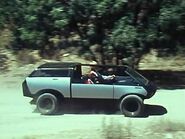| ARC Heavy Explorer | |

| |
| Purchasing | |
| Manufacturer: | Advanced Research Concepts |
| Cost to Own: | 55,000 Cr |
| Rental Cost: | 450 Cr plus 375 Cr/day |
| Transmission | |
| Propulsion Type: | Ground (wheeled) |
| Top Speed: | 125m/t (75kph) |
| Turn Speed: | 50m/t (30kph) |
| Acceleration Speed: | 24m/t |
| Deceleration Speed: | 18m/t |
| Power | |
| Powerplant: | x1 Type 1 power generator plus x2 Type 3 parabattery |
| Range: | unlimited on generator, on batteries 2,000km |
| Fuel Economy: | 2 SEU/km |
| Capacity | |
| Crew: | 1 |
| Passengers: | 3 |
| Cargo Limit: | 500kg, 5 cubic meters |
| Armaments: | x1 heavy laser (nose) |
| Armor: | Inertia Screen, Albedo coating |
| Other Equipment: | Cameras, environmental sensors, laboratory equipment, food synthesizer, radar, radiophone |
The ARC Heavy Explorer (known affectionately by operators as an "Ark") is one of the most sophisticated mobile laboratories to be found anywhere in Frontier space. It certainly is one of the most expensive, much more so than regular Explorer or Heavy Explorer types.
Arks are capable of providing a crew of four (driver and 3 mission specialists) with all the necessary facilities to conduct basic research/survey work for extended periods of time without outside support. Due to the extensive amount of installed equipment, the number of specialists cannot be increased. It is therefore necessary that expeditions utilizing Arks be more highly cross-trained than normal to be effective.
Rugged and reliable, Arks can be maintained with onboard micro-fabrication equipment except for the most extreme damage to major components. Food synthesis and water reclamation/purification systems virtually eliminate the need for external resupply in any environment where liquid water and basic organic materials exist, though the food thus produced will never be considered gourmet quality.[1]
Arks are powered by a Type 1 power generator supported by two Type 3 parabatteries. The power source is typically either solar, or a small RTG (Radioisotope Thermal Generator) power pack. This permits the vehicle to run at top speed while still charging one battery (the other being an emergency reserve). With judicious use, this arrangement permits the vehicle to operate around the clock if required.
Arks mount a full range of omni-directional cameras, basic environmental sensors measuring radiation, air quality, etc, as well as a short-range radar (range ~200km). The onboard facilities are capable of significantly more sophisticated analysis than portable environmental kits (+20% to Environmental skill checks), and the medical suite, though limited to one person at a time, counts as being a hospital for healing purposes.
Arks are radiation resistant, and are fully sealed against dangerous atmospheric conditions, and against submersion in water during amphibious crossings.

An "ark" in the field
Arks typically carry either one light ground or hover car,[2] or two to three ground cycles (informally known as Roamers) as auxiliary transport, as well as a jetpack, glijet, or other single-person aerial conveyance for impassable terrain.[3]
Arks are protected by Inertia screens and an Albedo coating.[4] A nose-mounted industrial/mining laser is included for removing travel obstacles (use Heavy Laser damage, but at one-quarter the range).[5]
Gallery[]
Notes & References[]
- Contributed by ChrisDonovan. Inspired by the Ark II television series, which belongs to Filmation Studios and/or CBS.
- ↑ Treat the food produced as Survival Rations, though a range of flavorings are available to make the rations palatable. The equipment (provided the required organic material is available) can produce enough food for four people per day.
- ↑ A light car reduces the passenger capacity of the ground car to 2, also reducing cargo capacity by half. Such vehicles use a Type I parabattery, but range remains the same due to greater "fuel economy".
- ↑ Instead of an aerial unit, some operators prefer to use this space to carry a robot equipped with either VTOL or Rocket movement types.
- ↑ Optional equipment rules introduced in Dragon Magazine #99; Tanks a Lot!
- ↑ Operators may request their units to be equipped with a normal heavy weapon of the usual types in addition, based on the environment(s) they are expected to work in.



